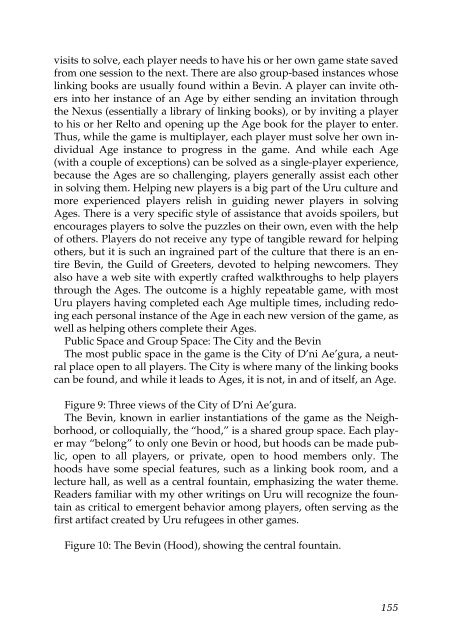Well Played 2.0: Video Games, Value and Meaning - OpenLibra
Well Played 2.0: Video Games, Value and Meaning - OpenLibra
Well Played 2.0: Video Games, Value and Meaning - OpenLibra
You also want an ePaper? Increase the reach of your titles
YUMPU automatically turns print PDFs into web optimized ePapers that Google loves.
visits to solve, each player needs to have his or her own game state saved<br />
from one session to the next. There are also group-based instances whose<br />
linking books are usually found within a Bevin. A player can invite others<br />
into her instance of an Age by either sending an invitation through<br />
the Nexus (essentially a library of linking books), or by inviting a player<br />
to his or her Relto <strong>and</strong> opening up the Age book for the player to enter.<br />
Thus, while the game is multiplayer, each player must solve her own individual<br />
Age instance to progress in the game. And while each Age<br />
(with a couple of exceptions) can be solved as a single-player experience,<br />
because the Ages are so challenging, players generally assist each other<br />
in solving them. Helping new players is a big part of the Uru culture <strong>and</strong><br />
more experienced players relish in guiding newer players in solving<br />
Ages. There is a very specific style of assistance that avoids spoilers, but<br />
encourages players to solve the puzzles on their own, even with the help<br />
of others. Players do not receive any type of tangible reward for helping<br />
others, but it is such an ingrained part of the culture that there is an entire<br />
Bevin, the Guild of Greeters, devoted to helping newcomers. They<br />
also have a web site with expertly crafted walkthroughs to help players<br />
through the Ages. The outcome is a highly repeatable game, with most<br />
Uru players having completed each Age multiple times, including redoing<br />
each personal instance of the Age in each new version of the game, as<br />
well as helping others complete their Ages.<br />
Public Space <strong>and</strong> Group Space: The City <strong>and</strong> the Bevin<br />
The most public space in the game is the City of D’ni Ae’gura, a neutral<br />
place open to all players. The City is where many of the linking books<br />
can be found, <strong>and</strong> while it leads to Ages, it is not, in <strong>and</strong> of itself, an Age.<br />
Figure 9: Three views of the City of D’ni Ae’gura.<br />
The Bevin, known in earlier instantiations of the game as the Neighborhood,<br />
or colloquially, the “hood,” is a shared group space. Each player<br />
may “belong” to only one Bevin or hood, but hoods can be made public,<br />
open to all players, or private, open to hood members only. The<br />
hoods have some special features, such as a linking book room, <strong>and</strong> a<br />
lecture hall, as well as a central fountain, emphasizing the water theme.<br />
Readers familiar with my other writings on Uru will recognize the fountain<br />
as critical to emergent behavior among players, often serving as the<br />
first artifact created by Uru refugees in other games.<br />
Figure 10: The Bevin (Hood), showing the central fountain.<br />
155

















